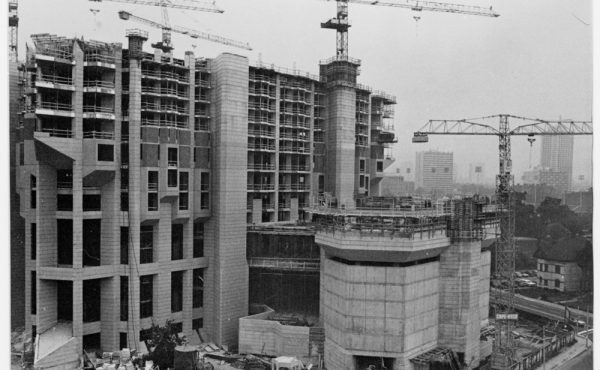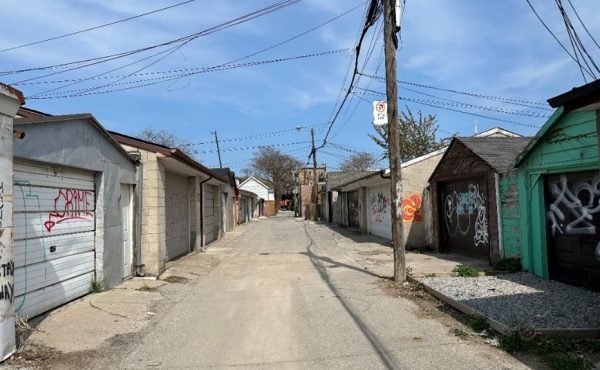

Though I maintain Toronto’s first architectural style was The Georgian, I want to give a more humble form of early architecture its time in the spotlight too: the log building. It’s a structure somewhat tied to our national mythology of intrepid settlers forging a new nation from his (and her) humble log dwelling. It seems like every Canadian childhood involved a trip to some sort of pioneer village, where log buildings were abound and the roots of our communities were on display and conveyed to us through timber.
In Canada the log house sprang up out of an odd set of circumstances. The big European powers that largely founded our county and influenced so much of our history (France and England) have no real tradition of building with logs. French Canadians began to use wood in their construction (though they were more inclined to use stone) because trees were so unavoidable here. However, when considering log buildings as we know them today, the credit goes to the Swedes who brought their traditional log architecture to North America. The short lived colony of New Sweden (1638-1655), located in present day Delaware at the mouth of the Delaware River introduced the log structures of Sweden to the English and Dutch settlers in the area. It was a suitable type of construction given the conditions in the area and eventually spread to all parts of the colonies. Loyalists brought it to Canada and British settlers began to build homes using the materials and techniques as well.
It is somewhat fitting then that the building regarded as Toronto’s oldest structure, Scadding Cabin, is built of logs. Reputed to have been built in 1795 and originally located on the east shore of the Don River near Queen Street, the house was moved to its present location on the Exhibition Grounds by the York Pioneer Society in 1879. An early example of an appreciation for local history, the move was planned to coincide with the opening of the Toronto Industrial Exhibition (or as we know it today, the CNE). Built for John Scadding, clerk to the first Lieutenant-Governor John Graves Simcoe, the one room cabin is constructed of squared, white pine logs with dovetailed corners. Though it is now completely removed from its original context, it is a demonstrative example of what some of Toronto’s earliest structures would have looked like. Structures like the Osterhout Log Cabin in the Guildwood Village area of Scarborough, built in 1795 for Augustus Jones, (also an early employee of Mr. Simcoe as Scarborough’s surveyor), the house is similar in layout and design as the Scadding Cabin and is Scarborough’s oldest building.
In Ontario the standard log house varied, but was often 16 by 20 feet (4.96 by 6.1m), which was stipulated in the general regulations as the minimum dimensions for a house in 1798. It was usually one storey high with a sleeping or storage loft beneath the gabled roof. The main room could be either one large space, or divided between a kitchen/living area and small bedrooms. The construction was concentrated at the corners, where ‘keys’ or ‘notches’ would assemble the logs. The simplest notch was a ‘saddle notch’ (where the rounded logs overlap at the corners and are held together with saddle shaped cuts near their projecting ends). More complicated, but providing more strength and stability, is the ‘dovetail joint’, in which the laps are angled somewhat like doves’ tails and fit closely together. Gaps between the logs were ‘chinked’ with mortar, moss or twigs. Roofs were clad with either cedar shingles or ‘scoops’ (half logs of pine that were hollowed out like troughs and laid side by side with the hollow side up with a second set placed on top, hollow side down).
Other early examples of log construction in Toronto can be found at Black Creek Pioneer Village. The Stong farmhouse, built in 1816 is actually original to the site. The Dalziel barn, built in 1809, originally located in North York is an unusual example of a German barn, constructed of logs with an overhanging second storey. At Fort York, the blockhouses built in 1813 (clad with wood siding) show the use of log construction for military purposes. Other examples used to be located throughout the countryside that once surrounded Toronto, but almost all of these have been modified beyond recognition, or destroyed. One of these examples is probably one of Toronto’s most fabled and interesting early buildings: Castle Frank. Built in 1795-96, for Lieutenant Govenor Simcoe as a summer retreat, the structure was a unique kind of log building. Described by Elizabeth Simcoe as being built “… on the plan of a Grecian Temple, totally of wood the logs squared and so grooved together that in case of decay any log may be taken out. The large pine trees make pillars for the porticos which are at each end 16 feet high.†Measuring 15×9 meters, it was a rustic temple with a log portico located in a picturesque landscape setting. The house was barely used before the Simcoes were recalled to England in 1796, and burned in the 1820s. As infrastructure and transport improved, frame and brick buildings were preferred, and with the ever present fear of fire to deal with, wood was often forbidden. With time it simply fell out of favour and has now almost entirely disappeared, except as craft or hobby cottages found outside of the city.
Editor’s Note: This post is an ongoing column exploring various architectural styles in and around Toronto. Spacing writer and heritage architecture consultant Thomas Wicks will look into the history of that style, the people behind it, and where in Toronto examples can be found.



5 comments
There’s a little white house on the east side of Broadview set at an odd angle between two big brick houses a little north of Gerrard at Riverdale. Under the stucco is a log cabin some have dated to the end of the eighteenth century, contemporary with the Scadding cabin.
The construction date and the cabin’s later ownership and renovation by the architect Langley are unestablished. but the suviving log construction’s for sure.
yes I believe that is called the John Cox house and was built around 1807. I was going to include as well but I wasn’t sure if the log construction had been substantiated. I’d be interested to know where other log houses in the city have been covered in stucco or siding disguising their true construction.
“The big European powers that largely founded our county and influenced so much of our history (France and England) have no real tradition of building with logs”. I am not sure I would agree with that. What did they make their massive fleets out of ? There was lots of carpentry knowledge in Europe and the Swedes were not that far away. Log houses are considered a European invention.
Hi Thomas
I used to live in the house on Broadview and yes it was certainly a log building. It is now a centre hall plan but the original log building included only the southern rooms and the hall. The Langley family added the northern rooms. In the attic you could still find the amazingly fine and incredibly thin wood shingles on the slope of the old roof of the cabin, now enclosed within the larger expanded attic. There really isn’t much to confirm the date of construction other than to say that it appears to predate 1807.
About the Osterhout Cabin, we were never able to find any solid research to confirm the age of the building, and archaeological work could only confirm a mid-19th century date.
Michael: thanks for the info and the confirmation on the Broadview ave house. Re the Osterhout Cabin, I guess the plaque should be changed to reflect the unsubstantiated construction date. Though it is still a fine early house.
Regarding the english and french having no tradition of building with logs I will clarify I meant they had no tradition of constructing buildings with horizontally placed logs one on top of the other in a manner that became so common in North America. That tradition is widely accepted as having come via the swedes or even germans. The french developed wood building techniques like Piece-sur-piece and Poteaux en coulisse in New France but this was a technique that wasn’t used in france where stone or half-timber construction was the norm.